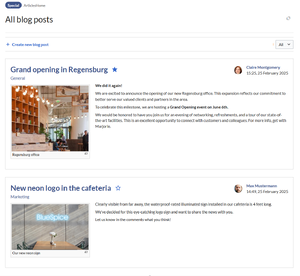No edit summary Tags: Reverted Visual edit |
No edit summary Tags: Reverted 2017 source edit |
||
| Line 1: | Line 1: | ||
BlueSpice goes beyond traditional documentation by integrating dynamic social features that foster interaction, personalization, and engagement with the wiki. | BlueSpice goes beyond traditional documentation by integrating dynamic social features that foster interaction, personalization, and engagement with the wiki. | ||
Tools like ''' | Tools like '''user mentions''', '''blogs''', '''user profiles''', and '''page comments''' transform the wiki into a more personalized collaborative space. | ||
==User mentions== | ==User mentions== | ||
You can mention another user by simply typing the <code>@</code>-Symbol and then selecting a username. This generates a link to the user's profile page and the user receives a notification with a link to this page from the wiki. | You can mention another user by simply typing the <code>@</code>-Symbol and then selecting a username. This generates a link to the user's profile page and the user receives a notification with a link to this page from the wiki. | ||
{{ButtonLink|external=no|target=Manual:Extension/AtMentions|label= | {{ButtonLink|external=no|target=Manual:Extension/AtMentions|label=More about user mentions|format=blue}} | ||
{{Clear}} | |||
==Blogs== | |||
[[File:Manual:blog special page-2.png|alt=Special page "ArticlesHome" with two blog entries|thumb|Blog page]] | |||
With this blog functionality, users find a space to share opinions, insights, and experiences that go beyond factual documentation. This fosters a culture of expertise and personal voice within the organization. | |||
The wiki includes two namespaces — <code>Blog</code> and <code>User_blog</code> — that are reserved for wiki pages of type <code>blog-page</code>. | |||
{{ButtonLink|external=no|target=Manual:Extension/AtMentions|label=More about blogs|format=blue}} | |||
= | |||
{{Clear}} | |||
==Page comments== | ==Page comments== | ||
<br /> {{translation}} | <br /> | ||
{{Clear}} | |||
==User profiles== | |||
Every user has a profile that is displayed on the page ''User:<username>''. Users can access their user profile by clicking on ''Profile'' in the user menu (located in the [[Manual:Extension/BlueSpiceDiscovery|header bar]]). | |||
The user profile shows the user's basic information (depending on the wiki setup) and the user's profile image. | |||
Below the user info, the user's wiki activities are listed: Comments the user made, actions on pages, and in general the user's activity on the wiki. It also allows other users to leave comments on the user's profile page.[[File:Profile1a-en.png|thumb|User profile|alt=User profile|center|650x650px]]{{translation}} | |||
[[Category:Social]] | [[Category:Social]] | ||
Revision as of 09:55, 13 August 2025
BlueSpice goes beyond traditional documentation by integrating dynamic social features that foster interaction, personalization, and engagement with the wiki.
Tools like user mentions, blogs, user profiles, and page comments transform the wiki into a more personalized collaborative space.
User mentions
You can mention another user by simply typing the @-Symbol and then selecting a username. This generates a link to the user's profile page and the user receives a notification with a link to this page from the wiki.
Blogs

With this blog functionality, users find a space to share opinions, insights, and experiences that go beyond factual documentation. This fosters a culture of expertise and personal voice within the organization.
The wiki includes two namespaces — Blog and User_blog — that are reserved for wiki pages of type blog-page.
Page comments
User profiles
Every user has a profile that is displayed on the page User:<username>. Users can access their user profile by clicking on Profile in the user menu (located in the header bar).
The user profile shows the user's basic information (depending on the wiki setup) and the user's profile image.
Below the user info, the user's wiki activities are listed: Comments the user made, actions on pages, and in general the user's activity on the wiki. It also allows other users to leave comments on the user's profile page.
